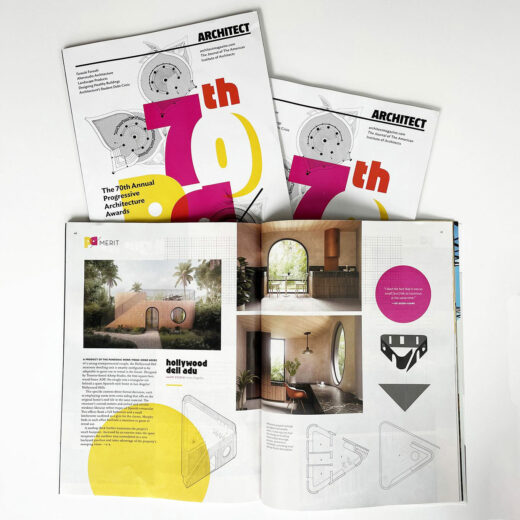Globe & Mail AAmp Studio’s Anne-Marie featured in Globe & Mail today!
Hope you can check out the feature on Anne-Marie and her fiancé’s mid-century home in Toronto, and AAmp’s forthcoming addition!
—
Pastel-yellow brick from Italy completes restoration of a 1956 Toronto building
By Dave Leblanc
Who would go to the trouble of having pastel-yellow glazed brick shipped all the way from Italy?
Or hunt for a terrazzo specialist to repair a few small holes in a staircase?
Who would weld their own floor-to-ceiling window-wall?
And what about those new plans for a second and partial third storey: who would respect the original massing, solids-and-voids, and even the ethos of this 1956 building? After all, it’s just an anonymous, blink-and-you’ll-miss-it former office building in Toronto.
But to mid-century modernism aficionados, 584 Jones Ave., south of the Danforth, was one of those “on the radar” places. Why? Because, in a neighbourhood of tall 1920s houses, this flat-roofed, elegant little 1,500-square-foot building stood apart. But, since much of that pastel brick had been covered by vinyl siding, and that handsome entryway on Hazelwood Avenue was partially hidden behind shrubbery, the former medical offices of Dr. Baggs and Dr. Coulter were coveted only by the most intrepid explorers.
Like graphic designer Todd Temporale of Viva and Co., who’d lived in this east end Toronto neighbourhood for years, and, in 2017, just happened to be in the market for a new home. When he saw the “For Sale” sign out front, he remembers thinking: “That’s it. That’s my building.”
“I pulled over, called my real estate friend Mark, and [said] ‘put an offer in’ and that was it. It was just the right place at the right time; sort of meant to be.”
Had this been 1997, once inside Mr. Temporale would’ve had to deal with a nurse’s station, a small lab, examination rooms, baby rooms, offices and a large waiting room; in the basement level, he would’ve had to tear out dentist’s offices and more even more examination rooms. But, since the building had been converted to a multi-unit residential building (with an office) in 1998, all he was needed was a sledgehammer in his hand, and one wielded by his buddy, Brandon Cambareri of Carmine Construction.
“It wasn’t very thoughtful, and it was pretty poorly done,” Mr. Temporale says of the stuff the duo swung away at and turned to debris. “I wish there were some original remnants left.”
Which brings this tale back to the glazed brick and the terrazzo stairs. When all one possesses are a precious few “remnants” of 1956, one becomes rather Gollum-like and treats them as the Precious. So, that damaged brick had to be replaced. Which is why, when architect Anne-Marie Armstrong of AAmp Studio entered the picture – she and Mr. Temporale are now engaged – the hunt was on.
“There’re a handful of companies [still producing glazed brick] locally, and most of them have a minimum order of 50,000 units before they’ll even run a colour, so it’s really difficult to find at this scale,” Ms. Armstrong says. “This place, S. Anselmo in Italy, who is supplied through Kreitmaker in Toronto, we were able to connect with them and they were willing … to do the custom colour.”
It helps, too, that Ms. Armstrong grew up surrounded by glazed brick (and other modernist treats) in Toronto’s “New Town” of Don Mills, and cut her professional teeth at U.S. firms Marmol Radziner and Gehry Partners. That kind of experience means one would not blink an eye, for instance, should Mr. Temporale were to take it upon himself learn how to weld … in the driveway.
By way of explanation: When one enters the building, one stands on a small landing; one must go up a half-level to reach the main floor, or down a half-level to the basement (this meant that offices and examination rooms in the basement received good light). When Mr. Temporale got the building, the wall that separated what would become his unit from the little staircase was mostly opaque, with only a few small, strangely placed windows. So, in keeping with the spirit of modernist principles, it was decided to replace this wall with a more commercial, thin-metal sash, floor-to-ceiling glass wall, albeit one with drapes he could pull when downstairs tenants come home.
“It’s not perfect,” Mr. Temporale says while running his thumb along a slightly bumpy weld-joint, “but I got a quote on it and I thought, ‘I’ll do it myself,’” he says with a laugh.
Once he’d figured out the floor plan and new beams, framing and drywall went up, it was time to finish his own 850-sqaure-foot unit. For that, he chose a very simple palette of materials, such as plain white ceramic tile for the backsplash and bathroom, and cost-effective solutions, such as having a wood shop press plastic laminate onto Baltic plywood so IKEA cabinets could be hacked into something a little more custom-looking (by sinking the IKEA boxes into some walls and placing a drywall reveal around them, the effect is quite elegant).
To accommodate his two children (with him part-time), Mr. Temporale made “teeny” bedrooms but gained space by building the beds “fully into the walls” and providing a bank of drawers underneath. And if one looks at the sizes of “master” bedrooms in condominiums, than Mr. Temporale is living in luxury with the amount of space he’s devoted to himself and Ms. Armstrong.
And when Ms. Armstrong’s addition is built, not only will it be aesthetically appropriate, it will allow the couple to move upstairs so that Viva and Co. can occupy the main floor.
And, perhaps, if there are any yellow bricks left over, they’ll make their way up there, too.

